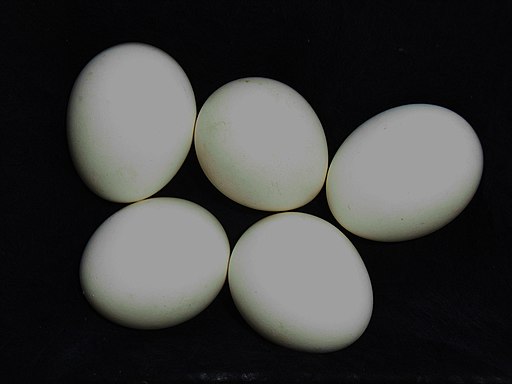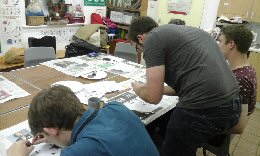Barn Owls of West Berkshire
A talk by John Dellow, followed by a practical session of pellet dissection
5 May 2016
John introduced himself as representing the West Berkshire Countryside Society, a body that was born out of the former FWAG a few years ago, and now comprises three groups: a barn owl group, friends of Bucklebury Heath, and a volunteers' group. He encouraged questions to be asked whenever they occurred to members of the audience, and the evening proceeded in a lively, interactive fashion, and the many tangents, once explored, were deftly eased back on course.
The barn owl group mounts, maintains and monitors a number of nest boxes throughout West Berkshire and has recently increased its coverage to around 150 boxes. These are mostly the Kintbury area between Newbury and Hungerford, and the Pang Valley between the M4 and A4, with a lesser cluster north of the motorway on the Yattendon Estate. The extremities are located in Ramsbury (W), Fobney (E), Hedley (S) and Chaddleworth (N).
Starting off with the photo of a "brancher" (a pre-fledge juvenile), found sitting on a nearby branch when he was checking a box, John explained the barn own is not the one that goes 'twit twoo' - that's the tawny owl. The barn owl, with its pale feathers, is silent in flight, usually making a noise only in the box. Examples photographed at Severall's Farm, Bradfield and Marlston Farm, Bucklebury, had been ringed for the purposes of research and records sent to the BTO.
Barn Owl Calendar
 Barn owls lay their eggs at the end of April and incubate them to end of May or early June. Surveys take place at the end of June, give or take a couple of weeks. Adults are very placid, willing to allow people to handle their young - unlike tawny owls which get very nasty when their box is opened. John recounted a time when one flew at him and took a lump out of his ear! He showed a photograph of local ringer, Pat Martin, ringing a still-fluffy juvenile. It takes ten weeks for the chicks to fledge, so there is not much summer left for a second brood unless the conditions have been exceptional. Surveying takes place in July, and then just selectively in September, at locations where second broods are considered likely. Barn owls lay their eggs at the end of April and incubate them to end of May or early June. Surveys take place at the end of June, give or take a couple of weeks. Adults are very placid, willing to allow people to handle their young - unlike tawny owls which get very nasty when their box is opened. John recounted a time when one flew at him and took a lump out of his ear! He showed a photograph of local ringer, Pat Martin, ringing a still-fluffy juvenile. It takes ten weeks for the chicks to fledge, so there is not much summer left for a second brood unless the conditions have been exceptional. Surveying takes place in July, and then just selectively in September, at locations where second broods are considered likely.
 The short tailed field vole is the key element in the barn owl's diet and their availability affects the owls' breeding success. Field voles thrive on a 3/4-year cycle and so while the figures for recent years appear to fluctuate wildly, it is probably the exceptional abundance of voles that explains the conspicuously higher numbers in 2014. The short tailed field vole is the key element in the barn owl's diet and their availability affects the owls' breeding success. Field voles thrive on a 3/4-year cycle and so while the figures for recent years appear to fluctuate wildly, it is probably the exceptional abundance of voles that explains the conspicuously higher numbers in 2014.
Asked what the limiting factor on population was, John referred to barn own expert Colin Shawyer who has argued for years that it was the availability of suitable habitat. Now Colin favours the availability of nest boxes as key; 70% of barn owls are box-bred. The West Berks Countryside Society has no target for an optimum number, as dedicated volunteers prepared to record are few and expansion cannot be based on the occasional activity of "dabblers".
Life cycle
John then showed a series of photographs tracing the development of newly hatched chicks through to fully fledged owls. He explained that eggs are laid in sequence, one day apart, and so the chicks hatch likewise. A photo of chicks with an egg intact nearby could indicate one of last year's that didn't develop, or the result of another species altogether, such as a stock dove - a species that often makes use of owl boxes. There is no nest as such in the box, just a depression in the detritus on the box floor.
The degree of detritus seen in the photographs indicates a disregard for hygiene; barn owls are not fastidious and the boxes soon fill up with a layer of "crud" as their inhabitants trample around amid discarded pellets. Indeed, in one photograph of a box at Pangfield, Stanford Dingley, there was a build-up of nearly a foot of pellet waste; it accumulates at a rate of about 2 inches a year. The boxes have to be cleared out every so often, during the uninhabited period over the winter months.
The young owls are ringed while still fluffy and when taken out of the box will adopt a defensive posture with claws facing forward. Equipment for ringing includes rings, pliers and a woolly jumper! When the owls are taken out, they are rigid, with wings tucked in and claws out font. If their heads are put under the ringer's jumper, the owls usually fall asleep!
Box location - where to put them
Barns traditionally are favoured, as grain attracts rodents and therefore a ready supply of prey. Other locations include granaries and prominent trees. There are several considerations in selecting a suitable site for a box, whether in trees or buildings, including: height, high visibility, aspect, clear flight path, away from roads and power lines, and in a suitable habitat for food supply. As boxes may be used for roosting as well as nesting - and as the male is banned from the boxes when the chicks are young and needs somewhere else to go - two boxes are often located in pairs, perhaps 200 - 300 yards apart.
The boxes
The WBCS has been fortunate in having boxes made by an enthusiastic volunteer carpenter who has made them for the price of the materials. (Marine ply is preferred, then ten seasons can be expected). If a landowner requests a box, it will cost him £80 plus permission to monitor. There is no charge to the landowner if the new location is the result of a WBCS request.
Until about three years ago boxes were of rectangular construction, but now the group favours a triangular design. These boxes will about last ten years and so a proportion of the total number installed has to be replaced each winter. Installations must be complete by the end of March for there to be a chance of breeding that summer.
The Law
To inspect an owl box one needs a permit: a 'disturbance licence' from English Nature, via BTO. The requirements for obtaining a ringing licence are rather more rigorous.
Intruders
A number of other species might be found inhabiting an owl box, including squirrels and jackdaws (a nuisance), stock doves (tolerated), kestrels and little owls (welcome). Hornets are best left alone! Perhaps 40-50% of boxes are occupied by intruders, so this is likely to affect owl numbers. Birds are protected by law and so intruders can't be ejected while in occupation, so nests are therefore cleared out when unoccupied during the winter.
Pellets
These are the indigestible components of an owl's diet - the fur and bones of prey - and are coughed up, rather than excreted. They are characteristic of owls but by no means restricted to them, as other bird species produce them too. 90% of a barn owl's diet consists of field voles, with shrews representing much of the remainder. Owls may also eat wood mice, as was illustrated by picture of a couple of carcasses found in a nest box at Rushall Manor Farm, and will eat other creatures if the opportunity presents itself. These other creatures include frogs, weasels, beetles, grasshoppers and small birds, but these, however, are rarely found.
Dissection Practical
 After a break for tea and cakes, the group turned to the inspection of owl pellets. John had treated them for the grubs that are often found inside by treating them for a minute in the microwave! He advised members to concentrate on the blacker pellets, each of which would usually contain two or three voles, and will represent the results of a night's hunting. He circulated some cards he had prepared of sample bones, laid out and annotated under sticky-backed plastic. (Tip: wipe sticky-backed plastic with a damp cloth before covering such samples, otherwise the bones will jump under the effect of static!). Each participant set to with tweezers, teasing away the fir from skulls and bones. Most were voles, but they varied in size and one at least found a shrew with its more pointed skull and red-tipped teeth. Eventually, the session concluded - vastly over schedule as a testament to a very interesting and highly successful evening. As we headed home, some of us at least had our trophies packed away in the conveniently empty cake boxes! After a break for tea and cakes, the group turned to the inspection of owl pellets. John had treated them for the grubs that are often found inside by treating them for a minute in the microwave! He advised members to concentrate on the blacker pellets, each of which would usually contain two or three voles, and will represent the results of a night's hunting. He circulated some cards he had prepared of sample bones, laid out and annotated under sticky-backed plastic. (Tip: wipe sticky-backed plastic with a damp cloth before covering such samples, otherwise the bones will jump under the effect of static!). Each participant set to with tweezers, teasing away the fir from skulls and bones. Most were voles, but they varied in size and one at least found a shrew with its more pointed skull and red-tipped teeth. Eventually, the session concluded - vastly over schedule as a testament to a very interesting and highly successful evening. As we headed home, some of us at least had our trophies packed away in the conveniently empty cake boxes!
Edwin Trout
|